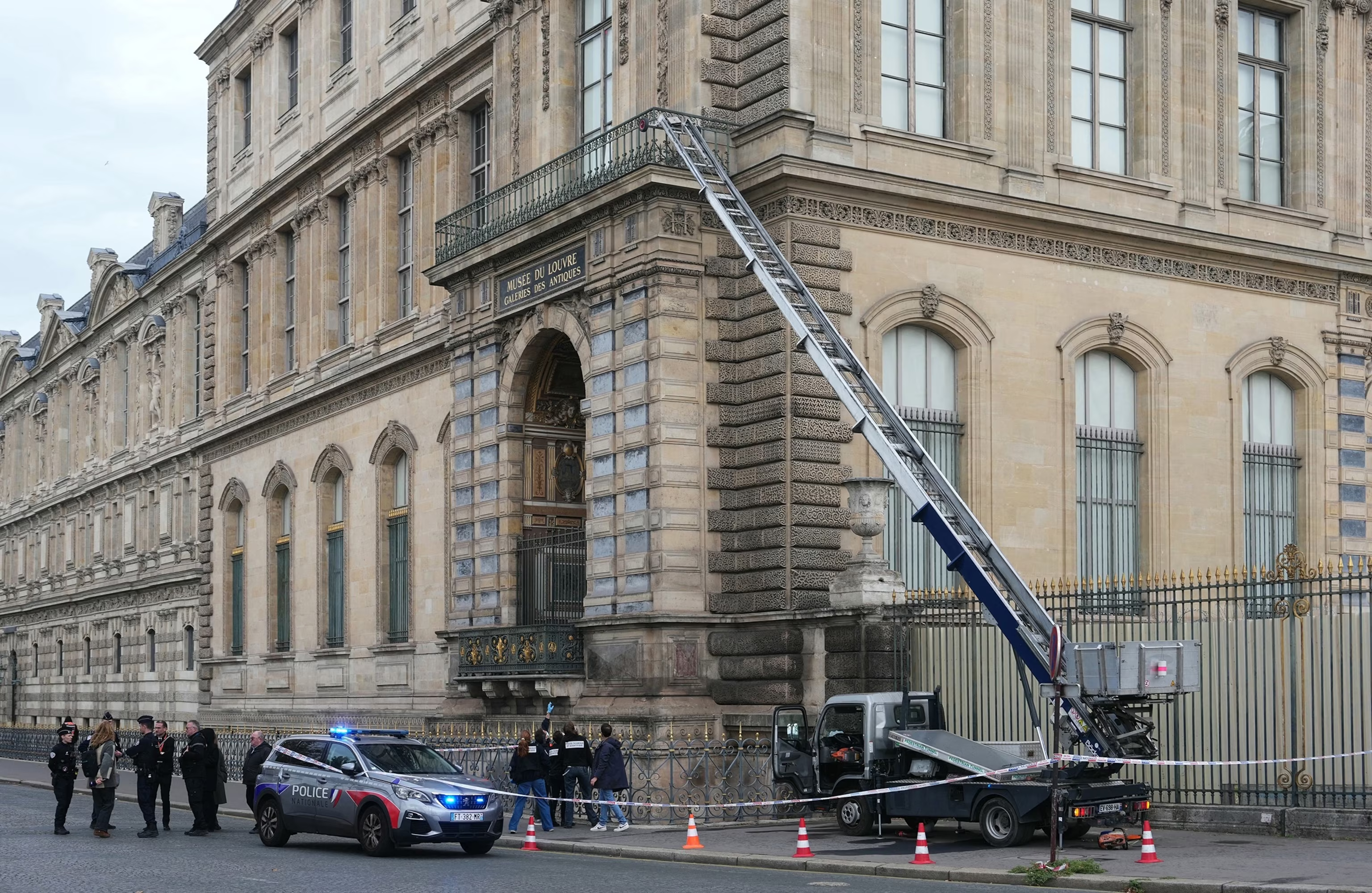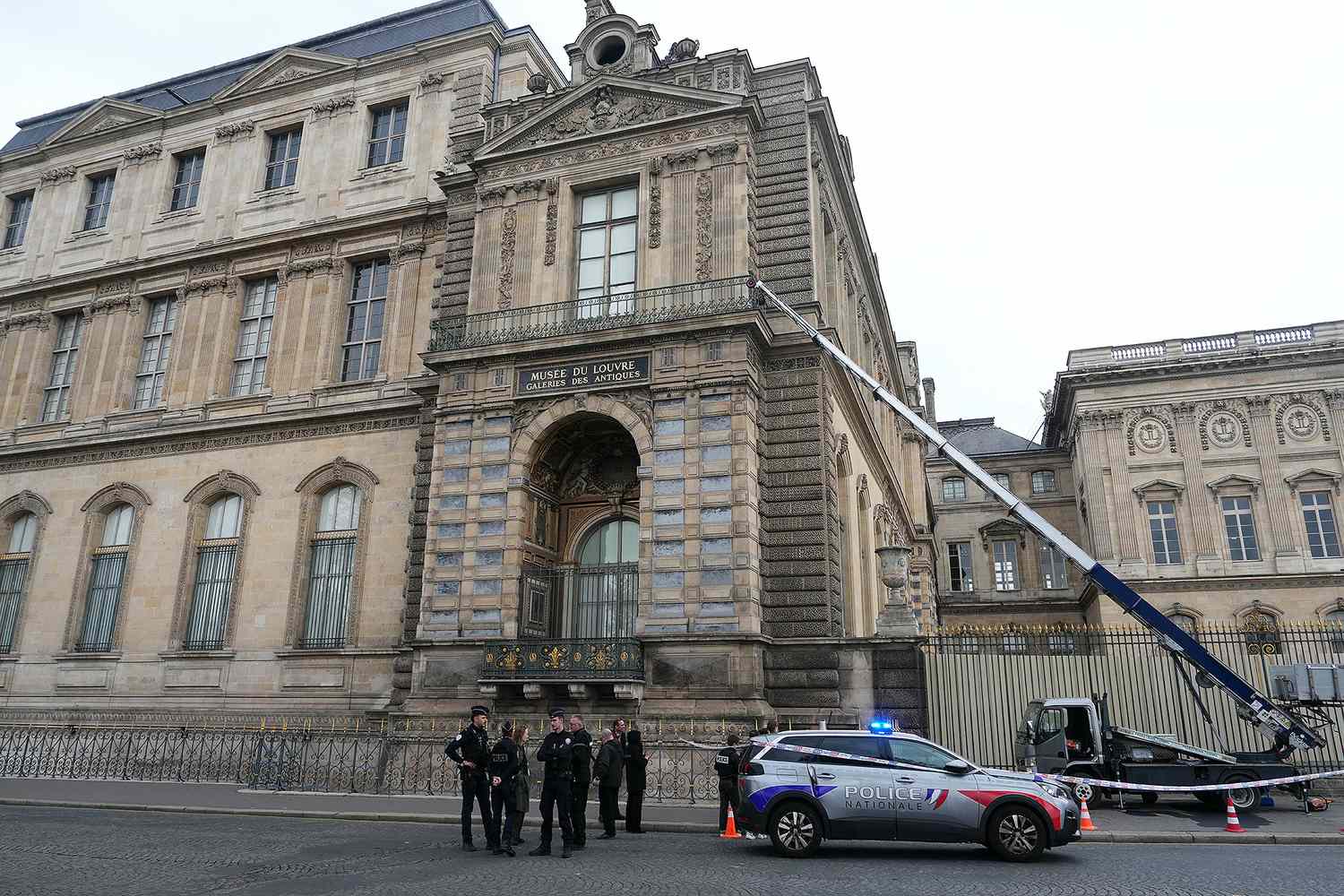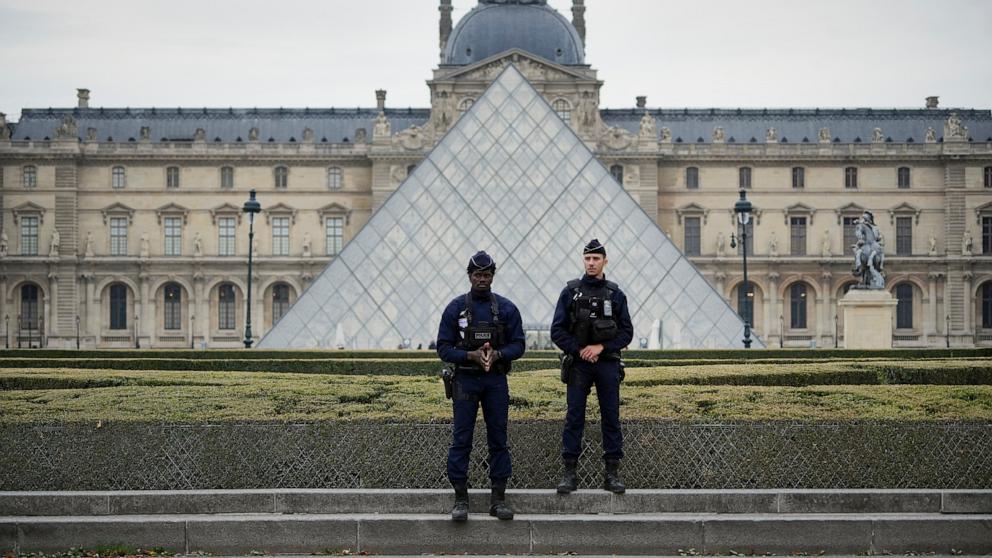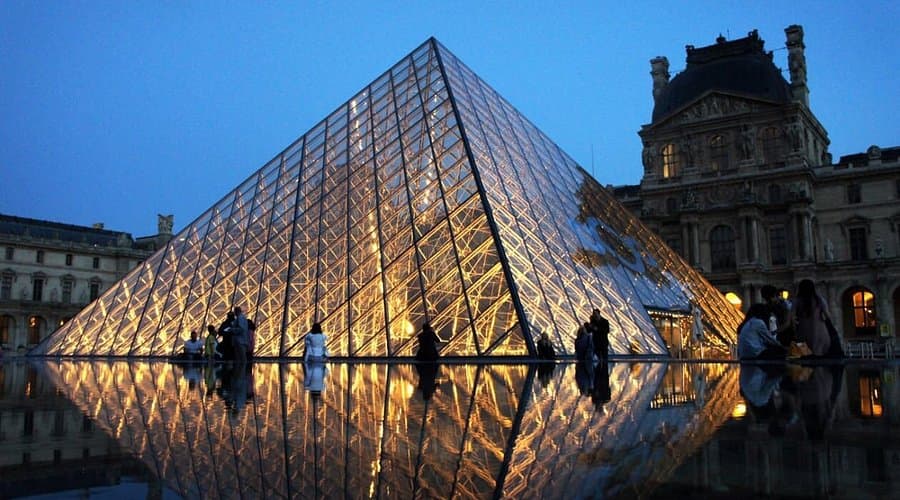On the crisp morning of Sunday, 19 October 2025, visitors streamed into the world-famous Louvre Museum in Paris unaware that within minutes one of the most dramatic thefts in recent cultural history would unfold. It was shortly after 9:30 a.m., roughly thirty minutes after the galleries opened, when a bold four-man team—disguised as construction workers—executed a lightning raid in the Galerie d’Apollon, home of France’s historic crown jewels.
The thieves arrived in broad daylight, using a large rental truck equipped with an extendable ladder and basket—a furniture-lift vehicle commonly seen in Parisian moving operations. That vehicle would prove the key to their entry. From the river-side façade along the Seine, they raised the cherry-picker up to a first-floor balcony, used the equipment to gain access, broke a glass window, disabled an alarm, and within approximately four minutes were inside the gallery vitrines. They smashed the display cases and made off with eight priceless jewellery items from the Napoleonic era; the total value has been estimated at around €88 million. They then escaped on motor scooters, disappearing into Paris traffic before the museum’s full shock had set in.
Security officials later admitted that the museum’s surveillance coverage was incomplete: external cameras facing the exact wall the thieves used were lacking. The Director of the Louvre, Laurence des Cars, addressed the Senate Culture Committee and acknowledged what she called a “terrible failure” of oversight.

How the robbery played out
It was meticulously timed and executed. The gang arrived with the specialized lift truck near the Quai François Mitterrand façade of the Louvre. Two masked men, wearing high-visibility vests to mimic workers, climbed the basket to the balcony of Galerie d’Apollon. They used angle grinders to cut through the window and smashed open display cases containing the jewels. The entire museum penetration—from window cut to exit—lasted under eight minutes, with the inside portion clocked at about four minutes.
Within that time they selected and removed eight pieces of jewellery—among them a tiara, an emerald and diamond necklace, and earrings that once belonged to queens and empresses of France. Curiously, they left behind some of the most famous items in the gallery, such as the 140-carat “Regent” diamond, valued at tens of millions but reputedly less tradeable because of its notoriety.
As they fled, the thieves made a critical error: they attempted to set fire to the lift’s basket platform to destroy evidence, but a museum staff member thwarted the ignition. Along their escape route they dropped one of the stolen crowns—it was later recovered, badly damaged.
The scene of the crime and forensic trail
Investigators arrived to found the disaster scene: cut glass, broken cases, a stolen lift parked nearby, blankets, high-visibility vests, helmets, gloves, angle-grinders, and gasoline canisters. More crucially, DNA traces and fingerprints were recovered—on a helmet and gloves abandoned at the scene. More than 150 forensic and fingerprint leads are now being followed.
Video footage from inside the museum captured the thieves descending the lift basket, two motor scooters waiting, alarms blaring in the background, as passers-by strolled along the Seine unaware of the drama. One voice can be heard saying in French: “They’re going to leave.” Seconds later, the two men mount scooters and vanish.
Why the robbery is so shocking
There are several reasons why this heist has captured global attention. First, the theft took place in broad daylight in what is arguably the world’s most visited museum. Second, the targeted items were national treasures with immense historical and symbolic value—not just material worth. Third, the sophistication and speed of the operation indicate professional planning and potentially inside knowledge. Fourth, the fact that they used a common moving-truck lift blatantly parked at the museum’s façade reflects how audacious the thieves were.
The French President, Emmanuel Macron, called the theft an “attack on a heritage we cherish because it is our history.” Interior and Culture Ministers described it as a “major robbery” of “immeasurable heritage value.”
Within France there has been political fallout: the museum trade unions and security staff say decades of understaffing and delayed signing-off on security upgrades left the Louvre vulnerable. The director offered her resignation, which was refused by the Ministry of Culture.

What comes next? The investigations and the fate of the jewels
The Paris prosecutor’s office has mobilised dozens of investigators; police are investigating the route of the lift rental, the truck and ladder theft, the scooters, CCTV footage from surrounding streets, and suspicious phone records. They are concerned that once the jewels are separated—diamonds removed from their settings, gold melted down—they will become much harder to recover or trace. The prosecutor stated there is only “small hope” of recovering the items in their original form.
One key question: where will the jewels end up? Experts believe they will not be sold intact—they are too famous; instead the likely scenario is that they will be disassembled and sold in parts, possibly into the black-market gem trade.
Meanwhile a curious twist to the story: the German company whose lift was used in the heist, Böcker Maschinenwerke GmbH, found itself unexpectedly in the spotlight. The lift model, “Agilo”, was identified by its own manufacturer and became a viral marketing moment: the company posted a tongue-in-cheek ad referencing the incident, which triggered controversy over taste and timing.
A broader message on museum security
This heist serves as a wake-up call not only for the Louvre but for museums worldwide. It demonstrates that determined criminals can exploit mundane tools (a furniture lift), daylight conditions, and assumed safety to strike massive blows. The fact that the thieves acted during opening hours, blended briefly into the public flow, and escaped on scooters suggests the need for rethinking perimeter security, façade surveillance, rapid response protocols, and the assumption that major thefts only happen overnight or during closed hours. Security audits at the Louvre had been made but implementation was still ongoing at the time of the theft.
For the public the story also raises uncomfortable questions: how safe are our national treasures? What value do we place on cultural heritage when it can be carried out of a building in minutes? What happens when the artefacts that anchor national identity are stolen, fractured, melted and lost forever?

Human dimension and symbolism
Beyond the technicalities of the robbery, the human dimension is chilling. Museum guards and visitors were startled but no violent confrontation occurred. Yet the psychological impact is profound. The heist didn’t just steal jewellery; it stole centuries of history, craftsmanship, lineage, and symbol. The tiaras and brooches were not just jewels—they were worn by queens and empresses, commissioned by emperors, witnessed by history. In that sense the thieves didn’t just take gold and diamonds—they took part of the French story.
The images will remain in public memory: the truck-lift parked beside the Seine, the thieves riding away on scooters, the media frenzy, the stunned museum staff, the shattered cases in the gallery that once held the crown jewels of France.
What to watch for in the coming days
Investigators will be digging into rental records and thefts of trucks and lifts in the Paris area. They’ll analyse telephone, SIM-cards, scooter GPS logs, CCTV footage on the Seine quays and side streets. They will watch the black-market gem trade for possible chatter or movement of large stones. They will question museum staff, contractors, rental companies. They will scour international customs and diamond-trade data for suspicious entries.
For the Louvre, there will be calls for major security reforms: façade camera coverage, upgraded glass panels, motion-sensing alarms, security-personnel numbers, visitor screening and perimeter controls. The museum reopened three days later—but the Galerie d’Apollon remains closed.
Final thought
In less than ten minutes, a robbery at one of the world’s most iconic museums stripped France of not just jewels—but a piece of its cultural soul. The audacity of the thieves, the speed of the operation, the value of the haul, and the symbolism of the loss combine to make this a story far bigger than the list of stolen objects. It’s a story about the vulnerability of heritage and the fragility of even the most fortified institutions. The clock is ticking—not only for the investigators hoping to recover the jewels, but for us all to confront how we protect what we value before it vanishes.
